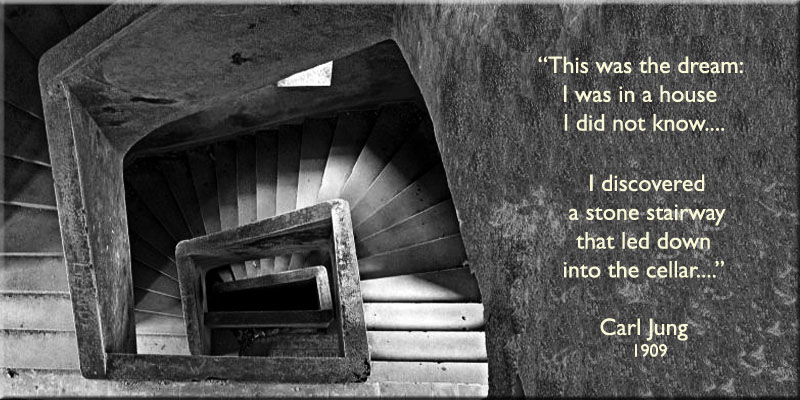C.G. Jung: “My dream thus constituted a kind of structural diagram of the human psyche.”

The dream that preceded Jung’s concept of the collective unconscious, with his comments about it, from Memories, Dreams, Reflections:
“This was the dream. I was in a house I did not know, which had two stories. It was ‘my house.’ I found myself in the upper story, where there was a kind of salon furnished with fine old pieces in rococo style. On the walls hung a number of precious old paintings. I wondered that this should be my house, and thought, ‘Not bad.’ But then it occtured to me that I did not know what the lower floor looked like. Descending the stairs, I reached the ground floor. There everything was much older, and I realized that this part of the house must date from about the fifteenth or sixteenth century. The furnishings were medieval; the floors were of red brick. Everywhere it was rather dark. I went from one room to another, thinking, ‘Now I really must explore the whole house.’ I came upon a heavy door, and opened it. Beyond it, I discovered a stone stairway that led down into the cellar. Descending again, I found myself in a beautifully vaulted room which looked exceedingly ancient. Examining the walls, I discovered layers of brick among the ordinary stone blocks, and chips of brick in the mortar. As soon as I saw this I knew that the walls dated from Roman times. My interest by now was intense. I looked more closely at the floor. It was of stone slabs, and in one of these I discovered a ring. When I pulled it, the stone slab lifted, and again I saw a stairway of narrow stone steps leading down into the depths. These, too, I descended, and entered a low cave cut into the rock. Thick dust lay on the floor, and in the dust were scattered bones and broken pottery, like remains of a primitive culture. I discovered two human skulls, obviously very old and half disintegrated. Then I awoke…
It was plain to me that the house represented a kind of image of the psyche–that is to say, of my then state of consciousness, with hitherto unconscious additions. Consciousness was represented by the salon. It had an inhabited atmosphere, in spite of its antiquated style.
The ground floor stood for the first level of the unconscious. The deeper I went, the more alien and the darker the scene came. In the cave, I discovered remains of a primitive culture, that is, the world of the primitive man within myself–a world which can scarcely be reached or illuminated by consciousness. The primitive psyche of man borders on the life of the animal soul, just as the caves of prehistoric times were usually inhabit by animals before men laid claim to them.
During this period I became aware of how keenly I felt the difference between Freud’s intellectual attitude and mine. I had grown up in the intensely historical atmosphere of Basel at the end of the nineteenth century, and had acquired, thanks to reading the old philosophers, some knowledge of the history of psychology. When I thought about dreams and the contents of the unconscious, I never did so without making historical comparisons;… . I was especially familiar with the writers of the eighteenth and early nineteenth century. Theirs was the world which had formed the atmosphere of my first-story salon….
The dream pointed out that there were further reaches to the state of consciousness… : the long uninhabited ground floor in medieval style, then the Roman cellar, and finally the prehistoric cave. These signified past times and passed stages of consciousness.
Certain questions had been much on my mind during the days preceding this dream. They were: On what premises is Freudian psychology founded?… What is the relationship of its almost exclusive personalism to general historical assumptions? My dream was giving me the answer. It obviously pointed to the foundations of cultural history–a history of successive layers of consciousness.
My dream thus constituted a kind of structural diagram of the human psyche; it postulated something of an altogether impersonal nature underlying that psyche. It ‘clicked,’ as the English have it–and the dream became for me a guiding image…
This was my first inkling of a collective a priori beneath the personal psyche.”

Pivotal dream!